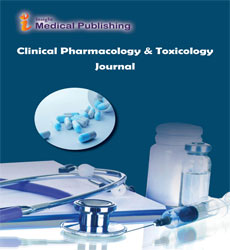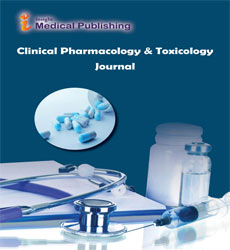Basic Principles & Testing Methods of Toxicology
Jiuming He*
Department of Natural Medicines, Institute of Materia Medica, Union Medical College, Beijing, China
- *Corresponding Author:
- Jiuming He Department of Natural Medicines, Institute of Materia Medica, Union Medical College, Beijing, China, Email: msawan17@ee.ceme.edu.pk
Received : December 01, 2021; Accepted : December 15, 2021; Published : December 22, 2021
Citation: Jiuming He (2021) Basic principles & Testing Methods of Toxicology. Clin Phar Toxi Jour. Vol.5 No.3. e001.
Toxicology is a logical discipline, encompassing science, science, pharmacology, and medicine, which includes the investigation of the antagonistic effects of biologically active organisms and the act of diagnosing and detecting open toxicity and toxicity. The link between the part and its effect on the uncovered organism is very important in toxicology. Factors influencing synthetic toxicity include proportions, exposure length (whether active or continuous), exposure course, animal species, age, gender, and climate. Toxicologists specialize in toxic and harmful substances. There is the development of evidence-based toxicology as part of a larger development towards evidence-based practices. Toxicology is currently adding to the field of cancer research, as certain toxins can be used as drugs to kill growth cells. One complete example of this is Ribosome Inactivating Proteins, which were tried to treat Leukemia.
Key Levels: The purpose of toxicity testing is to identify unfriendly effects of the substance. The opposing effects depend on two key factors: studies of openness (oral, internal air, or skin) and part (length and combination of openness). To investigate a part, things are tried in both solid and continuous forms. In particular, various diagnostic programs lead to the diagnosis of a specific cause of the disease and to consider different types of injuries. Factors affecting artificial toxicity: Ventilation, Both single (strong) exposure and small (continuous) non-persistent (continuous) openings are study, Route opening, Introduction, inhalation or absorption of skin, Other Feature, Type, Age, Gender, Health, Nature, Nature, Individual . Evidence-based toxicology discipline seeks to evaluate directly, honestly, and equally the available logical evidence to answer toxicology questions, the investigation of unfriendly material impacts, environmental, or environmental experts on species and climate, including avoidance. And the development of such impacts. Evidence-based toxicology may address concerns in the toxicological environment regarding the limitations of current approaches to assessing the state of science. This recalls concerns related to the directness of the direction, the combination of different types of evidence, and the testing of trends and authenticity. Evidence-based toxicology has its roots in major developments leading to evidence-based practices. Although experimentation on genetic models remains a strategy for assessing human impact, there are both ethical and special concerns about biological experiments. To an important foundation; refine the test to cause minimal suffering, and the subplant in vivo tests different methods for different species, or uses specific life forms whenever the situation allows. The PC display is an example of special testing techniques; using PC models of synthetic and protein components, completely unresolved structural action links, and composite designs that are likely to be bound, and block, potent, potent proteins, can be detected. This work requires basic knowledge in atomic display and detail as well as good judgment of science, science and toxicology. In 2007 the American NGO National Academy of Sciences published a report entitled "Harmfulness Testing in the 21st Century: A Vision and a Strategy" which opened with the statement: Sometimes important scientific moments include penicillin discovery, DNA doublefold helix specification, and PC development. Propels in hazardous genomics, bioinformatics, molecular science, epigenetics, and computational toxicology can change toxicity tests from the framework of whole-body experiments to basically based on in vitro techniques that monitor changes in biologic cycles using cells. cell lines, or cell. Parts, in fact of human origin.

Open Access Journals
- Aquaculture & Veterinary Science
- Chemistry & Chemical Sciences
- Clinical Sciences
- Engineering
- General Science
- Genetics & Molecular Biology
- Health Care & Nursing
- Immunology & Microbiology
- Materials Science
- Mathematics & Physics
- Medical Sciences
- Neurology & Psychiatry
- Oncology & Cancer Science
- Pharmaceutical Sciences
